September 24, 2021
If learning is a staircase, then all steps are not created equal. In math especially, some skills along the staircase are extraordinarily difficult for students to master. At Renaissance, we call these skills “Trip Steps” because they can cause a stumble in learning, just as an extraordinarily tall step in a staircase can cause an awkward bit of climbing.
Trip Steps were identified during the empirical validation process that we use to develop our state-specific learning progressions. When the teachable order of skills is plotted against data on their relative difficulty, some skills are found to be disproportionately difficult for students to master. These are the Trip Steps.
Although Trips Steps exist in reading, we find far more of them in mathematics. This is because math is “ruthlessly cumulative,” to use Stephen Pinker’s phrase. For example, the Trip Step Find the area of a rectangle by multiplying side lengths is introduced in the latter half of third grade in most states. This is an important skill that lays the foundation for future success in geometry and problem solving. Yet it is extraordinarily difficult for most third graders to learn, because multiplication is generally introduced late in third grade, as is finding area by multiplying rather than by tiling. Essentially, new skill + new process = potential for some students to “trip.” Trip Steps have profound effects on future learning in math. Trip over one and you’re likely to trip over another. “Ruthlessly cumulative,” indeed.
This is not to say that Renaissance is dismissing Trip Steps for Reading. On the contrary, we continue our work with both reading and math Trip Steps. However, considering the COVID-19 pandemic’s impact on math learning and growth—as documented in the full-year edition of our How Kids Are Performing report—we began our work with an intense focus on mathematics. So let’s take a closer look at math Trip Steps, and consider why they will be so critical for math recovery this school year.
Trip Steps and accelerated learning
Not long after school buildings closed in March 2020, conversations began to shift from where students learn to what they must learn in order to build knowledge and continue growing. Much of the conversation and ensuing guidance focuses on accelerating learning. While acceleration naturally suggests hastening or hurrying, the concept of accelerated learning is intently focused on prioritizing instruction—meaning, identifying the standards and skills that are most important in each grade level or course.
In the summer of 2020, Renaissance launched the Focus Skills Resource Center, a free resource for all who are vested in learning. Focus Skills are found at every grade level and across all domains of reading and mathematics. Essentially, Focus Skills are the building blocks of student learning and are tied directly to each state’s learning standards. Each Focus Skill is:
- Fundamental to student understanding
- A prerequisite for future learning
- Reflective of the state’s grade-level expectations
Because Focus Skills are critical to learning at grade level while also setting the stage for future grades, they—by definition—provide educators with a pathway to prioritization.
Some Focus Skills have also been identified as Trip Steps. This means that these skills are critical for learning at grade level and are especially challenging for students to acquire. Identifying these unique math skills—Focus Skills that are also Trip Steps—provides educators with a means to further prioritize instruction and plan for impactful learning experiences. This is especially important now, given the need to make up lost instructional ground due to the pandemic’s disruptions. And the How Kids Are Performing report shows the urgency of this challenge, with students across grades 2–8 ending the 2020–2021 school year 11 weeks behind expectations in math, on average.
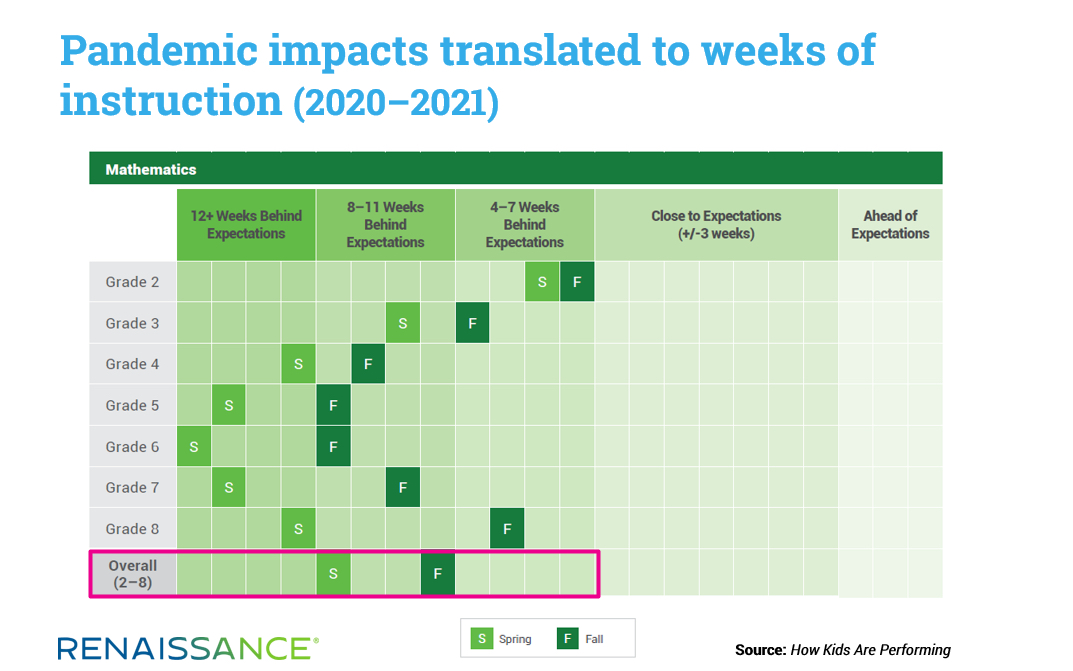
How are Trip Steps identified?
Renaissance’s learning progressions describe the incremental way that students acquire knowledge—moving from lesser to more sophisticated understanding—within a subject area. This is the staircase we mentioned earlier. Each state’s academic standards define the goals that students must reach at each grade level. A Renaissance state-specific learning progression supports each student’s journey up the staircase to reach those goals, from pre-K through high school.
The order of the steps, or skills, in a learning progression is based on the foundation of pedagogy, skill difficulty data, and each state’s standards requirements. Of course, most educators have an intuitive sense of which steps or skills in a student’s learning journey are most challenging—for example, Divide mixed numbers or fractions for middle school students. After refining learning progression order for more than 10 years and analyzing millions of student assessments, Renaissance has identified the specific skills that are disproportionately difficult.
The graph below illustrates the difficulty data we use to identify Trip Steps. Skills are listed in learning progression order and are identified by grade level (x-axis) and difficulty (y-axis). Difficulty is based on student responses to items in our Star Math assessment. The majority of skills cluster near the yellow trend line. Skills significantly above the trend line are Trip Steps.
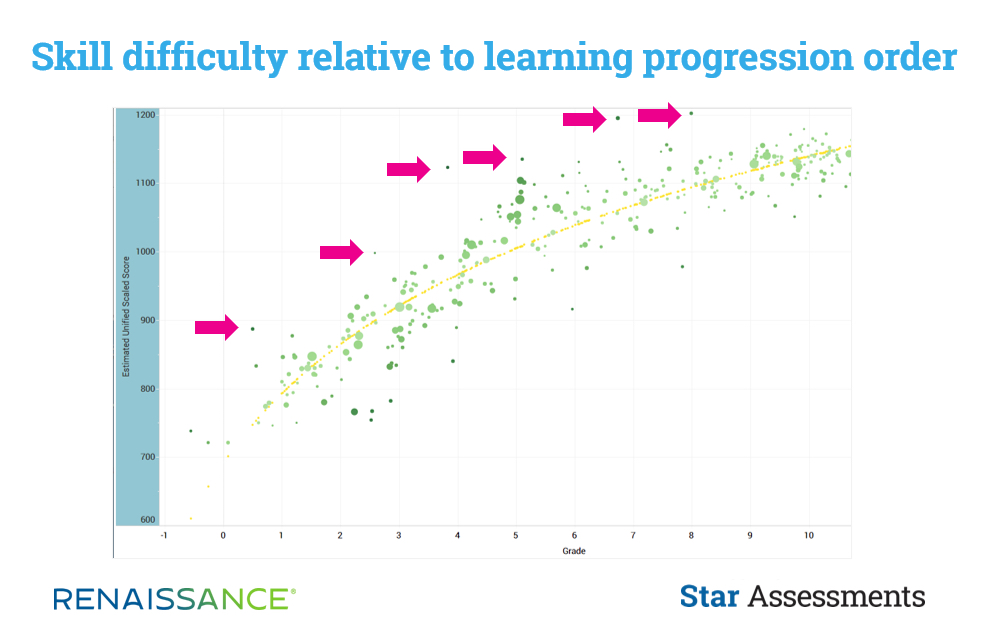
The higher above the trend line a skill is, the more difficult the skill is compared to other skills in that grade—and the more support a student may need to achieve that Trip Step.
Which skill area has the most Trip Steps?
Geometry & Measurement is the skill area with the most Trip Steps across grade levels. The graphic below shows a selection of these Trip Steps from grades 3–7 to illustrate the cumulative effect mentioned earlier.
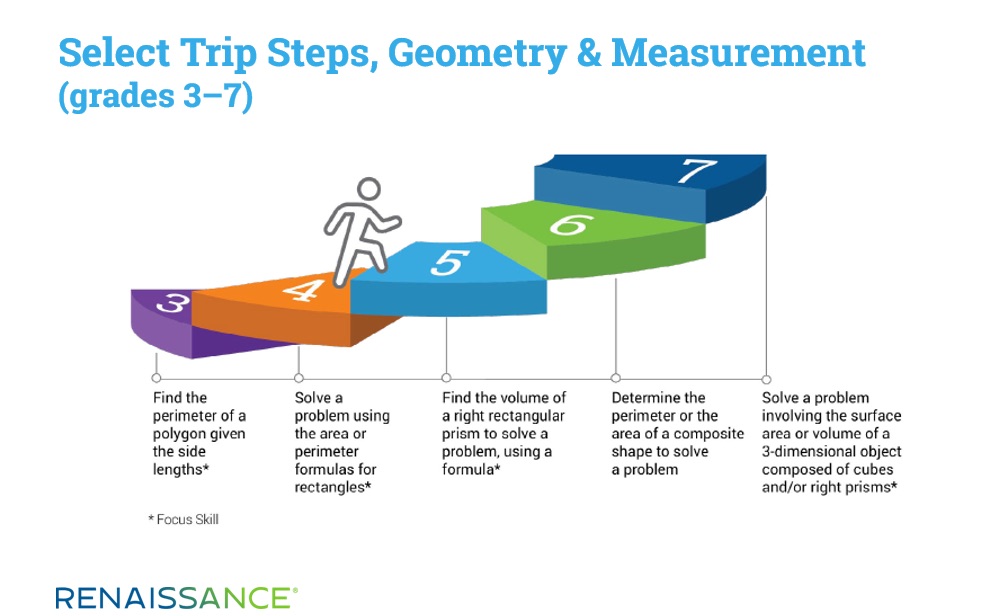
Not all Trip Steps require extra instructional time and deep student mastery but—as noted earlier—Trip Steps that are also Focus Skills warrant close attention, because they’re important prerequisites for future learning. For a student to be prepared for the challenging Trip Step Solve a problem involving the surface area or volume of a 3-dimensional object at grade 7, the student will need to have already mastered the grade 4 Trip Step Solve a problem using the area or perimeter formulas for rectangles.
Grades 4 and 5 have the most math Trip Steps, reflecting the shift in the complexity of Geometry & Measurement processes listed above. These Trip Steps also reflect the transition in this grade range from Whole Numbers to Fractions. The table below shows the Trip Steps that exist in this critical transition.
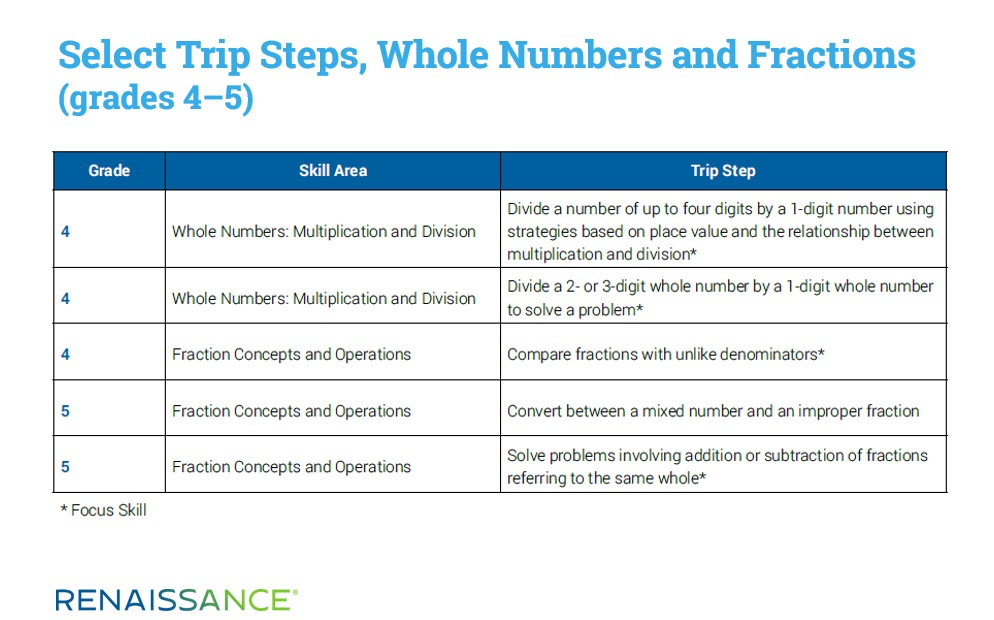
The Focus Skills in the table above also provide further examples of important prerequisite relationships, like the grade 4 skill Compare fractions with unlike denominators and the grade 5 skill Solve problems involving addition or subtraction of fractions referring to the same whole.
It’s interesting to consider the prevalence of Trip Steps in grades 4 and 5 and student performance by grade level last school year, as documented in How Kids Are Performing. The table below summarizes expected versus actual student performance in Spring 2021. For students in grades 4 and 5, the scaled score difference was -21 and -18, respectively. This is a greater difference than in grades 6–8, for example, where the number of Trip Steps is lower.
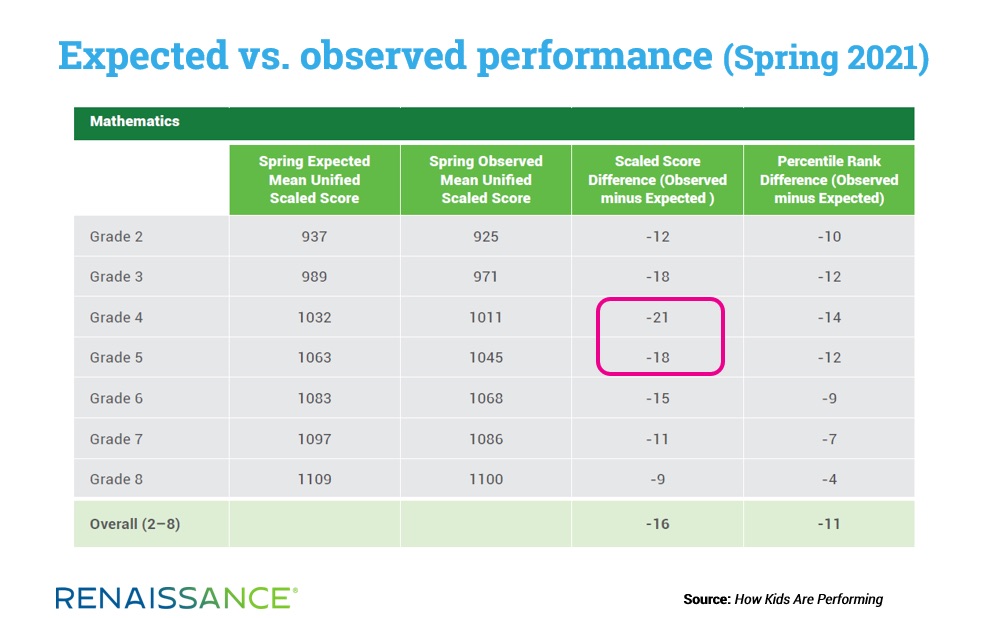
You can find instructional support ideas for challenging middle school math skills here.
Trip Steps and math recovery
Dr. Amit Sood, a noted authority on resiliency and former professor of medicine at the Mayo Clinic, writes that our brains, by default, are attuned to everything happening around us—often creating a noisy “dialogue” in our heads. When focus and prioritization are required, first we must mute this dialogue to activate the brain’s “task-positive network.” State standards and curricula documents may include such “noise.” In a pandemic-free school year, the noise is manageable; not so in school years focused on recovery and growth. Focus Skills and Trip Steps help you to mute some of the standards/skills dialogue, activate your and your students’ task-positive networks, and accelerate learning. We suggest that teachers:
- Review math Trip Steps for your grade level or course
- Identify the prerequisite skills associated with each Trip Step
- Plan with math colleagues and share resources, techniques, and expertise related to Trip Steps
- Nurture positive mindsets by explaining to students that the skill may seem difficult, but, step-by-step, they can master it
- Share strategic feedback with students (more on this below)
- Assess student readiness for each Trip Step with an activity, observation, or brief quiz
- Engage in just-in-time support as needed
- Monitor developing mastery
Your feedback is critical to students’ perceptions of themselves as “math persons,” and teaching is as much about care and compassion as it is about instruction and motivation. When we see students’ frustration, it’s natural to comfort them—natural and necessary. Simply temper that comfort with a quick focus on finding out where the problem-solving went astray and implement just-in-time support to get students back on track (e.g., “It’s OK that you feel frustrated. Let’s fix this.”) You’ll find more information on the power of math identity and feedback here.
Why our work with Trip Steps continues
At Renaissance, we continue to look for relationships among Trip Steps, Focus Skills, how students are performing, and how they are really learning. There is always something more to learn, and there are always remarkable findings to share. To learn more about Focus Skills, and to see the most critical math and reading skills in your state, visit our Focus Skills Resource Center. To see a list of math Trip Steps that are also Focus Skills, click here. And to see the most urgent instructional needs this school year, download the new edition of How Kids Are Performing.
References
Pinker, S. (1997). How the mind works. New York: Norton.
Sood, A. (2013). The Mayo Clinic guide to stress-free living. New York: DaCapo.
Learn more
Looking for more insights on Trip Steps and math recovery? Watch our recent webinar for tips on teaching these challenging skills and raising student motivation.

